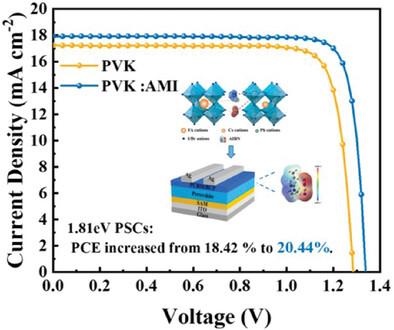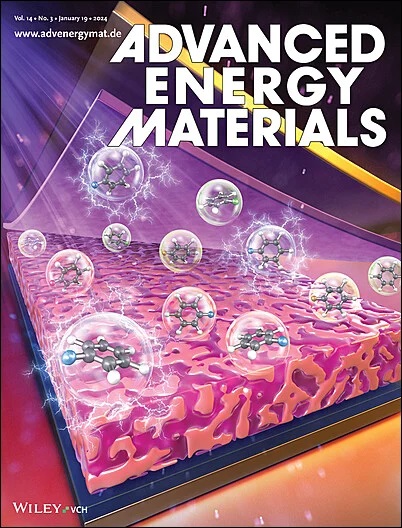表面电位均匀化提高了包晶体太阳能电池的性能
IF 24.4
1区 材料科学
Q1 CHEMISTRY, PHYSICAL
引用次数: 0
摘要
通过阳离子和/或卤化物合金化合成多组分金属卤化物包光体(MHPs)可以调整带隙、优化性能和提高稳定性。然而,这些多组分材料往往存在成分、结构和性质上的不均匀性,导致卤化铅包晶石中载流子传输不均匀和严重的非辐射重组损耗。虽然许多研究人员都关注过氧化物卤化离子的聚集,但表面电位的影响却相对较少受到关注。在这项研究中,将多功能离子液体 1-烯丙基-3-甲基咪唑二氰胺(AMI)引入到包晶前驱体中,以有效调节包晶层的表面电位。这种方法可抑制非辐射重组,增强载流子注入,提高器件性能。包晶石层内的表面电位均匀化可同时提高包晶石太阳能电池的效率和稳定性。对于宽带隙(1.81 eV)的包晶石,最佳功率转换效率(PCE)达到 20.44%,开路电压(Voc)为 1.339 V,短路电流密度(Jsc)为 17.92 mA cm-2,填充因子(FF)高达 85%。事实证明,这种策略对于常规带隙的透辉石太阳能电池(PSCs)(1.53 eV)也很有效,从而显著提高了性能,PCE 从 23.22% 提高到 25.41%。本文章由计算机程序翻译,如有差异,请以英文原文为准。

Surface Potential Homogenization Improves Perovskite Solar Cell Performance
The synthesis of multicomponent metal halide perovskites (MHPs) by cationic and/or halide alloying allows band gap tuning, optimizing performance and improving stability. However, these multicomponent materials often suffer from compositional, structural, and property inhomogeneities, leading to uneven carrier transport and significant non-radiative recombination losses in lead halide perovskites. While many researchers have focused on the aggregation of perovskite halide ions, the impact of the surface potential has received relatively less attention. In this study, the multifunctional ionic liquid 1-allyl-3-methylimidazole dicyanamide (AMI) is introduced into the perovskite precursor to effectively regulate the surface potential of the perovskite layer. This approach inhibits non-radiative recombination, enhances carrier injection, and improves device performance. Surface potential homogenization within the perovskite layer leads to simultaneous improvements in both the efficiency and stability of perovskite solar cells. For wide-bandgap perovskites (1.81 eV), the optimal power conversion efficiency (PCE) reaches 20.44%, with an open-circuit voltage (Voc) of 1.339 V, a short-circuit current density (Jsc) of 17.92 mA cm−2, and a high fill factor (FF) of 85%. This strategy also proved effective for conventional bandgap perovskite solar cells (PSCs) (1.53 eV), leading to a significant increase in performance, with the PCE increasing from 23.22% to 25.41%.
求助全文
通过发布文献求助,成功后即可免费获取论文全文。
去求助
来源期刊

Advanced Energy Materials
CHEMISTRY, PHYSICAL-ENERGY & FUELS
CiteScore
41.90
自引率
4.00%
发文量
889
审稿时长
1.4 months
期刊介绍:
Established in 2011, Advanced Energy Materials is an international, interdisciplinary, English-language journal that focuses on materials used in energy harvesting, conversion, and storage. It is regarded as a top-quality journal alongside Advanced Materials, Advanced Functional Materials, and Small.
With a 2022 Impact Factor of 27.8, Advanced Energy Materials is considered a prime source for the best energy-related research. The journal covers a wide range of topics in energy-related research, including organic and inorganic photovoltaics, batteries and supercapacitors, fuel cells, hydrogen generation and storage, thermoelectrics, water splitting and photocatalysis, solar fuels and thermosolar power, magnetocalorics, and piezoelectronics.
The readership of Advanced Energy Materials includes materials scientists, chemists, physicists, and engineers in both academia and industry. The journal is indexed in various databases and collections, such as Advanced Technologies & Aerospace Database, FIZ Karlsruhe, INSPEC (IET), Science Citation Index Expanded, Technology Collection, and Web of Science, among others.
 求助内容:
求助内容: 应助结果提醒方式:
应助结果提醒方式:


